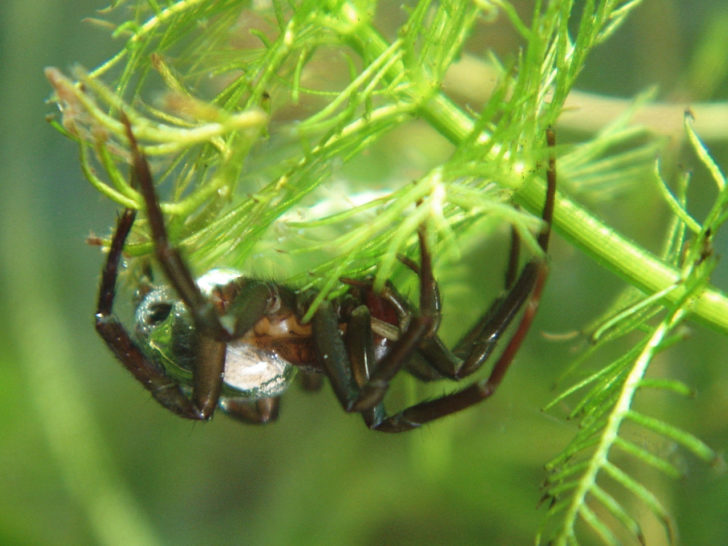Nanobionics used to create unsinkable metal

The water spider Argyroneta aquatica weaves a fine web that gives it the ability of buoyancy. Inspired by this marvelous creature, researchers at University of Rochester have created an unsinkable metal.
Metals are obviously much denser than water, so they always sink - and do so quite rapidly. In order to have metal float on water, it needs to be shaped into a hollow space with air inside as is done in hulls of boats or submarines at high expense and intense labor. Alternatively, the metal can be equipped with floatation panels, a method currently used for example in swimming buoys.
There is yet another alternative for which nature holds the patent. Water spiders, water bugs and fire ants all use special, nanoscale structures to keep them afloat. Thanks to their nanostructured anatomy, a thin layer of air is created between the body and water surface. This layer of air not only achieves buoyancy but also makes the insects feet extremely hydrophobic, efficiently preventing them from becoming wet. Using this as a model, US scientists have created an unsinkable metal. A special nanostructure engraved by a laser and a two-layered structure make for an incorruptible buoyant force. In the future, this new method could be used for swimming sensory, boats and buoys.
Argyroneta aquatica weaves a fine web
A. aquatica weaves a very fine net that serves as a diving bell, giving the insect its name, the diving bell spider. This net is superhydrophobic, creating a strong buoyant force by encapsulating air. To attain such strong water-repellent properties, materials create a thin layer of air on a complex surface. This makes it impossible for any water to adhere to the materials surface and all water departs from the in-between-layer as droplets. This principle is nothing new, and scientist from the University of Rochester have been able to create similar structures with laser engraving for several years already, making metals water-repellent and more resistant to corrosion. In all cases however, the buoyant force was too weak and the metal objects always sunk as a result. This method was continuously developed and improved, now resulting, for the first time, in unsinkable metals.
In a first step, the metal was made superhydrophobic by the laser engraving process. Ultra-high-speed laser pulses create nano- and microscale patterns on the surface. This automatically results in large amounts of air being encapsulated into the metal, but in the past, strong frictional forces between water and metal caused the nanostructures to wear down, eventually resulting in the loss of the desired water-repellent properties. To circumvent this problem, the scientists decided to no longer shape the outside surface of the metals, instead combining two engraved metal plates with the nano-structured surfaces facing towards each other – like a metal sandwich. The two metal plates are only connected via a small connecting post in the middle.
An unsinkable metal despite load application
This newly shaped metal structure now includes a very small gap between the two plates. The size of the gap was chosen carefully by the scientists to achieve optimum water-repellency by capturing nothing but air inside. This air is what makes the metal unsinkable and it is almost impossible to remove due to the nanostructures that create a superhydrophobic environment between the two plates. Even when fully submerged, the gap remains filled with air, without any water entering. The scientists are thrilled by their discovery. The nanostructured metals exhibit an unprecedented floatability and even resurface after being submerged under water for several months. The floating ability is remarkably stable as the air-filled gap remains intact despite holes in the metal or even damages in the nanostructures. Thus, the metal is unsinkable. To prove this assertion, the new metal surfaces were submerged for two months by application of high loads. Experiments were conducted by scientists of University of Rochester and from the Chinese “Changchun Institute of Optics, Fine Mechanics, and Physics”. After removing the force, the structures immediately jumped back to the water surface. Even metal plates in which the scientists drilled six holes with differently sized diameters remained afloat, showing that major damage in the form of holes does not impair the floating capability.
Added value for sensors, buoys and even boats
This new technique works for any type of metal, making the scientists confident that unsinkable metals can be used in many different applications. They envision the use of superhydrophobic metal structures for different water-going vessels, swimming aids and for protection of electronic equipment. Using this technique in swimming sensors would be particularly desirable. The water-repellent casing would keep water from the delicate electronic equipment and at the same time make the floatation device redundant. If used, unsinkable metal could allow ships, floatation and electrical monitoring devices to remain functional even after prolonged time under water and avoid damages.
Original article (German): https://www.ingenieur.de/technik/fachbereiche/nanotechnologie/unsinkbares-metall-dank-nanostruktur-und-doppelschicht/